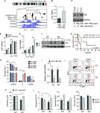Myeloid malignancies with chromosome 5q deletions acquire a dependency on an intrachromosomal NF-κB gene network
- PMID: 25199827
- PMCID: PMC4237069
- DOI: 10.1016/j.celrep.2014.07.062
Myeloid malignancies with chromosome 5q deletions acquire a dependency on an intrachromosomal NF-κB gene network
Abstract
Chromosome 5q deletions (del[5q]) are common in high-risk (HR) myelodysplastic syndrome (MDS) and acute myeloid leukemia (AML); however, the gene regulatory networks that sustain these aggressive diseases are unknown. Reduced miR-146a expression in del(5q) HR MDS/AML and miR-146a(-/-) hematopoietic stem/progenitor cells (HSPCs) results in TRAF6/NF-κB activation. Increased survival and proliferation of HSPCs from miR-146a(low) HR MDS/AML is sustained by a neighboring haploid gene, SQSTM1 (p62), expressed from the intact 5q allele. Overexpression of p62 from the intact allele occurs through NF-κB-dependent feedforward signaling mediated by miR-146a deficiency. p62 is necessary for TRAF6-mediated NF-κB signaling, as disrupting the p62-TRAF6 signaling complex results in cell-cycle arrest and apoptosis of MDS/AML cells. Thus, del(5q) HR MDS/AML employs an intrachromosomal gene network involving loss of miR-146a and haploid overexpression of p62 via NF-κB to sustain TRAF6/NF-κB signaling for cell survival and proliferation. Interfering with the p62-TRAF6 signaling complex represents a therapeutic option in miR-146a-deficient and aggressive del(5q) MDS/AML.
Copyright © 2014 The Authors. Published by Elsevier Inc. All rights reserved.
Figures





References
-
- Beg AA, Sha WC, Bronson RT, Baltimore D. Constitutive NF-kappa B activation, enhanced granulopoiesis, and neonatal lethality in I kappa B alpha-deficient mice. Genes Dev. 1995;9:2736–2746. - PubMed
-
- Chen FE, Huang DB, Chen YQ, Ghosh G. Crystal structure of p50/p65 heterodimer of transcription factor NF-kappaB bound to DNA. Nature. 1998;391:410–413. - PubMed
Publication types
MeSH terms
Substances
Associated data
- Actions
Grants and funding
LinkOut - more resources
Full Text Sources
Other Literature Sources
Medical
Molecular Biology Databases
Research Materials
Miscellaneous

